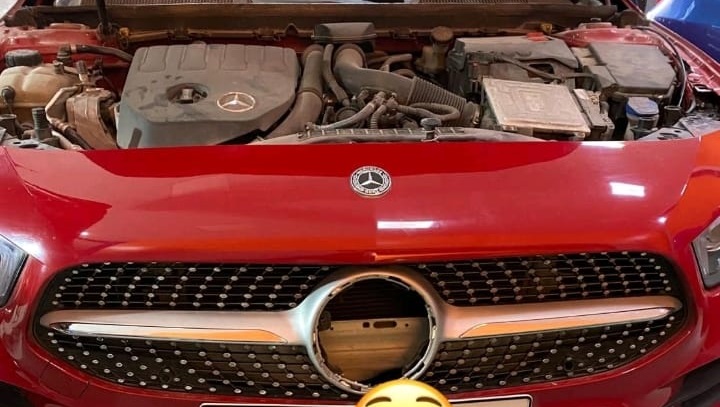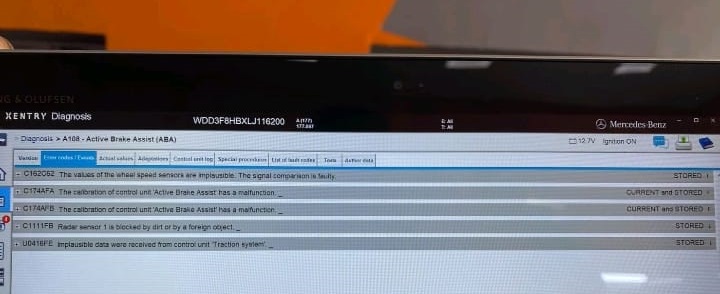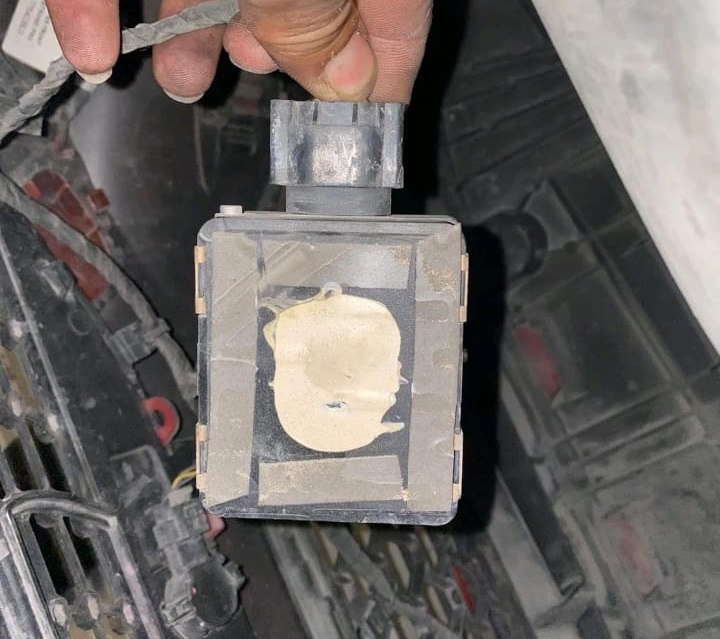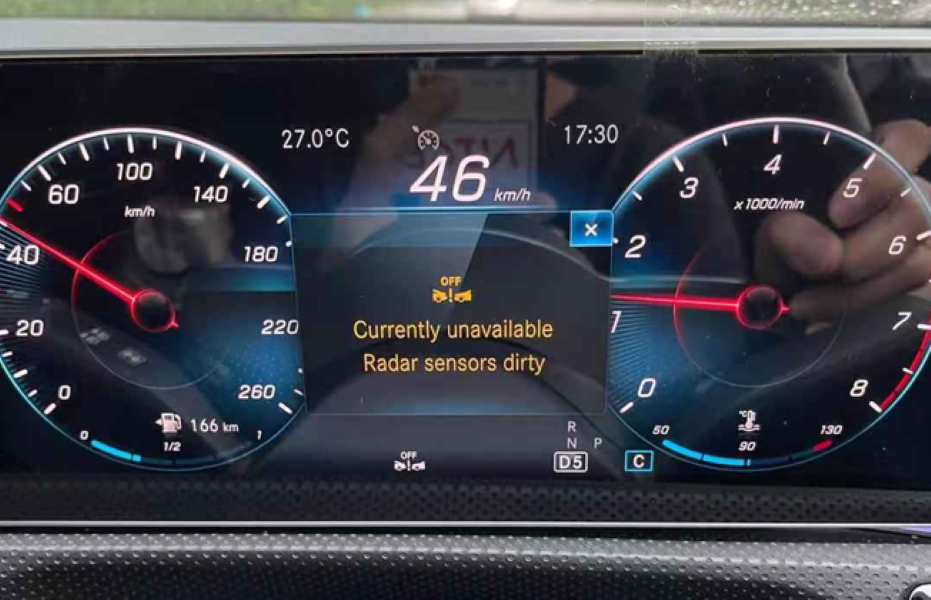Table of Contents
Radar Sensor Dirty”; Why It Appears & How to Fix It
A “Radar Sensor Dirty” warning (or “Radar sensors are dirty see operator’s manual”) signals that your Mercedes’ radar-based safety systems like Active Brake Assist, Adaptive Cruise Control, or Blind Spot Assist may be impaired due to sensor blockage.
What Does “Radar Sensor Dirty” Mean?
Mercedes Radar Sensor Dirty is a warning message that highlights an important but often overlooked issue sensor obstruction. In modern vehicles, radar sensors are essential for advanced driver-assistance systems such as Active Brake Assist, Blind Spot Assist, and Adaptive Cruise Control.
When these sensors become dirty due to dust, mud, snow, or road grime, their performance can be compromised, leading to temporary system deactivation and potential safety risks.
Radar sensor dirty is more than just a maintenance alert it’s a reminder of how vital sensor visibility is for accurate readings and reliable performance. In a case study involving a Mercedes CLA W118, the warning appeared due to dirt buildup on the front radar sensor located behind the front bumper.
As soon as the sensor was cleaned and the area inspected for damage or permanent obstruction, the radar system returned to normal operation without the need for further intervention.
radar sensor dirty can typically be resolved through regular cleaning of the front and rear bumpers where radar units are mounted. However, if the message persists after cleaning, a deeper inspection may be necessary to check for internal sensor faults or alignment issues.
Keeping these sensors clean ensures that critical safety systems remain fully functional, allowing your Mercedes to operate with precision, confidence, and peace of mind.

What does radar sensor dirty mean on Mercedes?
The Radar Sensor Dirty message in your Mercedes indicates that the radar sensor, which is used for various driver assistance systems such as adaptive cruise control and collision avoidance, is obstructed or dirty. This obstruction can prevent the sensor from functioning correctly, potentially impacting the performance of these safety systems.
What Triggers the Warning & How to Identify It
- 1. Dirt and Debris: Accumulation of dirt, mud, snow, or road salt on the sensor can trigger this message.
- 2. Weather Conditions: Adverse weather like heavy rain, snow, or fog can temporarily affect the sensor’s ability to function.
- 3. Obstructions: Objects such as leaves, ice, or even bumper stickers or license plate frames that cover the sensor area can cause this issue.
- 4. Damaged Sensor: Physical damage to the sensor from impacts or accidents can result in this warning.
- 5. Misalignment: The sensor may be misaligned due to a minor collision or improper repair.
Steps to Address the Issue:
- 1. Clean the Sensor: Check the location of the radar sensor (usually located in the front grille or bumper) and clean it gently with a soft cloth and mild soap if necessary. Avoid using abrasive materials that could scratch the sensor.
- 2. Check for Obstructions: Ensure there are no objects obstructing the sensor. Remove any visible debris or ice.
- 3. Inspect for Damage: Look for any signs of physical damage to the sensor. If damaged, it may require professional repair or replacement.
- 4. Check Alignment: If the sensor appears misaligned, a professional technician should inspect and realign it.
| Cause | Indicator | Check / Diagnose |
|---|---|---|
| Road grime, mud, bugs, rain | Warning on dash; ADAS disabled | Inspect front grille, bumper, and windshield sensors for visible dirt/debris |
| Snow or ice buildup | Warning during cold weather | Gently remove ice sensor malfunction may fade once clear |
| Sensor misalignment or damage | Warning persists post-cleaning | Visual check and diagnostic scan; look for impacts or misalignment |
| Software glitch | Warning remains after cleaning | Reset system (ignition OFF/ON), clear codes, or update firmware |
How to Clean & Restore Sensor Function
1. Locate the radar sensor: usually in the grille or front bumper.
2. Turn off your vehicle.
3. Gently wipe with a soft microfiber cloth dampened with mild soap and water no hard scrubbing
4. Dry completely to avoid moisture-related faults.
5. Restart the car and check if the warning disappears.
DIY vs Professional Fixes
| Action | DIY? | Professional? |
|---|---|---|
| Clean sensor lens | Yes | Not required |
| Remove ice/debris | Yes | Not required |
| Inspect for physical damage | Yes | Unless sensor is damaged |
| Soft reset | Yes | Not needed |
| Sensor alignment check | Maybe | Better done by trained technician |
| Deep diagnostic scan | Recommended if the alert persists | |
| Sensor replacement | Essential if cracked or misaligned |
Case Study Highlights
Case study #1: Radar sensor dirty Message displayed on Mercedes CLA W118
A customer is fully satisfied with their Mercedes CLA W118, primarily due to its functionality of assisted emergency braking. This option provides them with a sense of safety and confidence, especially in critical situations on the road. With this cutting-edge technology, the car can detect imminent dangers and intervene swiftly to avoid accidents or reduce their severity.
For this owner, this remarkable feature makes all the difference, adding an additional dimension to the driving experience and reinforcing the trust bond with their vehicle.

Deciding to enhance the aesthetic appeal of his Mercedes CLA W118, the owner opts to replace the bumper with a model from the Mercedes AMG range. This decision is motivated by the desire to add an extra touch of elegance to his already exceptional vehicle.
The AMG bumper, renowned for its distinctive design and high-end finish, will elevate the appearance of the CLA W118 while preserving its sporty character. For this car enthusiast, this modification represents a way to personalize his car according to his aesthetic tastes and preferences, adding a touch of sophistication to his driving experience.
After replacing the bumper on his Mercedes CLA W118, the driver is surprised to see an unexpected message displayed on the dashboard: Radar Sensor Dirty. This notification raises concerns about the operation of the vehicle’s radar sensors, which appear to have been affected by the aesthetic modification.
Although the new AMG bumper adds an elegant touch, it seems to have compromised the ability of the radar sensors to function properly.
This situation highlights the importance of considering the potential implications on safety and assisted driving systems when making any modifications to a vehicle. The driver now faces the need to find a solution to restore the functionality of the radar sensors and ensure safety during his journeys.

Following the diagnostic test conducted by the technician, several error codes are discovered, recorded on the active brake assist control unit. These codes reveal a malfunction related to the calibration of the brake assist control unit, thus explaining the error message displayed and the issues encountered with the radar sensors.
This anomaly underscores the critical importance of the proper functioning of each component in the advanced safety systems of modern vehicles.

The mystery behind the message Radar Sensor Dirty on the dashboard of the Mercedes CLA W118 is finally resolved after removing the bumper and visually inspecting the radar sensor.
The technician responsible for the bumper modification did not properly reinstall the radar sensor in its appropriate location, suitable for this model of AMG bumper. This error explains why the radar sensor is now inoperative, compromising the vehicle’s assisted safety functionalities.
To remedy this situation, it is imperative to reinstall the radar sensor correctly in its designated position to ensure its proper operation. This setback underscores the crucial importance of precise installation in accordance with specifications to guarantee the integrity of modern vehicle’s advanced safety systems.
Once this correction is made, the driver will once again be able to fully enjoy all the safety features of their Mercedes CLA W118.

After properly reinstalling the radar sensor in its appropriate location and conducting a road balancing, the technician successfully resolved the issue. This intervention restored the functionality of the radar sensors in the Mercedes CLA W118, eliminating the error message and ensuring the proper operation of the assisted safety systems.
This success underscores the importance of precise technical expertise and a methodical approach to diagnosing and resolving issues related to electronic components and advanced vehicle systems. Now, the owner can fully enjoy their car, with confidence in its safety and performance on the road.
Case study #2 : Collision Avoidance System Failure in Heavy Rain
During recent testing, our Mercedes A Class W177 displayed a warning on the instrument cluster indicating that the radar sensors were dirty and the collision avoidance system was unavailable.
This issue ‘radar sensor dirty‘ occurred while driving in heavy rain on the motorway. Given the significance of this fault, we conducted a detailed diagnostic scan using the Autel MS906 tool to better understand the cause and timeline of the fault.

Diagnostic Process
1. Fault Detection Using Autel MS906 Diagnostic Tool
- – A diagnostic scan revealed a stored fault code related to the radar sensor.
- – Freeze frame data was available, providing valuable information about the vehicle’s status at the time of the fault.
2. Analyzing the Freeze Frame Data
- – The stored data included key metrics such as wiper settings, accelerator position, braking status, and speed range.
- – By cross-referencing this data, we confirmed the fault’s occurrence matched the time the warning was displayed on the instrument cluster during the motorway drive in heavy rain.


Insights from the Data
Operational Implications:
The fault code indicated that the radar sensors were obstructed and unable to function properly, leading to the deactivation of the collision avoidance system.
Potential Legal & Safety Relevance:
This information is particularly useful in the context of serious accidents. If a driver claims that the collision avoidance system should have activated to prevent an accident, the recorded fault code offers evidence that the system was temporarily disabled.
Even if the fault message no longer appears on the cluster, the error remains stored in the ECU, traceable with a diagnostic scan.
Data Limitations:
While the fault data records when the system became unavailable, it does not indicate when the sensors resumed proper function. This lack of information could complicate efforts to establish whether the safety feature was operational at the time of a crash.
Absence of Crash Data Retrieval (CDR) Support:
Notably, Mercedes vehicles in the UK do not support CDR retrieval for pre-crash data, which means freeze frame data like this becomes even more critical when investigating post-collision scenarios.
Manufacturer Data Transmission
Remote Data Storage:
Mercedes-Benz vehicles may transmit fault data to the manufacturer’s headquarters for further analysis. This can be particularly relevant if a customer alleges that safety systems were not working as intended.
In such cases, the manufacturer may rely on this remote data to defend against claims, ensuring the brand’s reputation is safeguarded.
Conclusion
This case highlights the importance of monitoring and investigating fault codes, especially in safety-critical systems like collision avoidance. By utilizing diagnostic tools like the Autel MS906, vehicle operators can verify whether safety features were functional during crucial moments.
Furthermore, it underscores the challenges posed by the absence of CDR retrieval for Mercedes in the UK, emphasizing the value of freeze frame data in accident investigations.
Case Study #3: Mercedes-Benz A200 Front Radar Sensor Fault Fixed
In this real-world example, a Mercedes-Benz A200 experienced persistent radar-related errors following a front-end accident. The front radar sensor had been physically damaged during the collision, leading to a series of fault codes being logged in the system.

Fault Codes Identified:
- – B220662 – The current Vehicle Identification Number (VIN) is incorrect or not present. Signal comparison is faulty.
- – C163691 – The calibration of the ‘Front Radar Sensor’ has a malfunction. The parameter is outside the permissible range.
- – B182700 – The coding of the control unit is incomplete.

To resolve the issue, the front radar sensor unit was replaced with a new OEM part. However, simply installing the new sensor was not sufficient. The repair process required three crucial steps to fully restore the system:

- – VIN Programming – The new radar unit was updated with the correct Vehicle Identification Number to match the car’s configuration.
- – Control Unit Coding – The radar control unit was correctly coded to ensure communication and compatibility with other ADAS modules.
- – Radar Calibration – A precise calibration procedure was carried out using specialized diagnostic equipment to align the radar’s parameters within acceptable limits.
Once these steps were completed, all fault codes were cleared, and the vehicle’s Advanced Driver Assistance Systems (ADAS) returned to normal operation.
This case underscores the importance of not only replacing damaged hardware but also performing the necessary programming and calibration procedures when working with radar sensors in modern Mercedes-Benz vehicles.
Real Owner Experiences
“After cleaning mine it cleared for a day, but then came back. Dealer found corrosion on the radar sensor plug had to replace the connector.”
— User on MBWorld.org
“If you had a recent bumper replacement or alignment, the radar might be slightly off-angle. Happened to me, and the dealer had to recalibrate it.”
— Reddit user /r/mercedes_benz
Preventive Care Table
| Condition | Action |
|---|---|
| Heavy rain, mud, snow | Clean sensors after driving in these conditions |
| Following wash or detailing | Use micro-cloth, mild soap, no pressure |
| After collision or bumper work | Have sensors realigned/calibrated by a specialist |
| Every service interval | Include sensor inspection during routine check-ups |
Where is the radar sensor Mercedes located?
Radar sensor Mercedes location
The radar sensor in most Mercedes compacts is located behind the front bumper on the right side, as you see in the image below.

Step-by-Step: Clean & Restore Sensor Function
- – Turn off the car and park in a shaded, calm area.
- – Locate sensors typically behind front grille/bumpers or near windscreen/star emblem.
- – Clean gently with a microfibre cloth, warm water + mild soap avoid pressure washers.
- – Remove ice or debris carefully, without prying off sensors or covers.
- – Dry thoroughly, then restart the car and check if the message disappears.
- – Soft reset not solving it? Re-scan ADAS system via dealer tools or update firmware
How to replace radar sensor in Mercedes CLA and A-CLass ?
you can replace the Mercedes A Class W177 and CLA 118 radar sensor by following the following steps looking at the image above;
- 1. Remove the front bumper and place it on a suitable support.
- 2. Unlock and disconnect the electrical connector from radar sensor (A108).
- 3. Unhook radar sensor (A108) from the mounting bracket and remove it from the support (1).
- 4. Commission the radar sensor (A108).
- 5. Carry out the calibration of the radar sensor (A108).
Frequently Asked Questions
What causes “Radar Sensor Dirty” message?
Usually dirt, debris, ice, or sensor misalignment preventing proper radar function.
Can I fix it myself?
Yes, clean the sensor gently and restart the vehicle. If it persists, have it checked by a professional.
How often should I clean the sensor?
Clean after heavy rain, snow, mud, or whenever the warning appears, to ensure system accuracy.






Leave a Reply